San People
The San or Basarwa people live on the vast territory of Kalahari desert which is divided among 3 countries – South Africa, Botswana and Namibia. Some San communities exist in Angola too.
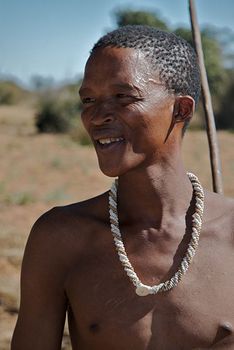 San man
San man
The San are often called Bushmen. The word "bushman" is rather pejorative. It comes from the Dutch word, "bossiesman", which means "bandit" or "outlaw". White people start calling the San that way some 200 years ago.
At the moment there are about 95,000 San people. But only 3,000 of them kept their traditional lifestyle of hunters and gatherers. It is believed that the San people have one of the oldest cultures on our planet. Their culture is more than 100,000 years old.
The San traditionally live in groups of about 20 people. Groups include family members and there is no chief or something like that. Decisions are made on consensus. Still certain knowledge like those of hunters is highly respected.
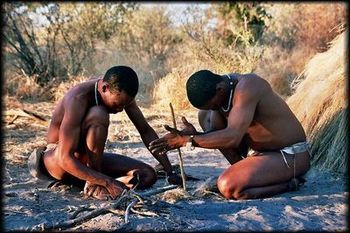 San men trying to start a fire
San men trying to start a fire
If bigger disagreements happen the group just splits and go their own separate ways. Few times a year different groups meet to exchange news and presents. Marriage arrangements are sometimes made too.
The San constantly move from area to area in search of food and water. They often follow migration routes of animals. They live in huts made of branches with some grass on top.
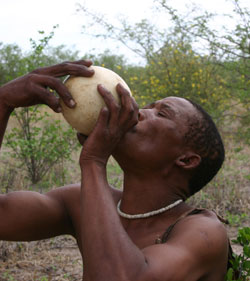 San man drinking (photo by DVL2)
San man drinking (photo by DVL2)
Men are hunters. They use traps, bows and poisoned arrows. Various poisons are used - snake venom, the poison from the caterpillar called "ka" or "ngwa", poison from for example euphorbia plant. The poison does not make the animal it kills dangerous for food. The hunter just cuts out the piece of animal flesh around the place where the arrow struck the body.
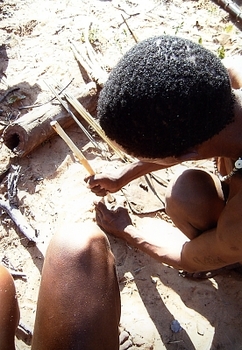 San men making poisoned arrows
San men making poisoned arrows
Each hunter has a special leather bag. In the bag he carries some medicine, tools, arrows etc. He carries the bag on one of his shoulders. Women are gatherers of wild fruits and vegetables. Sometimes men help them too.
The San eat all kind of animals and plants. They eat different fish, insects, snakes but also zebras, antelopes etc. All parts of the animal are used. Nothing is wasted. Bones, for example, are crushed for the marrow.
Considering the fact that they live in part of the World where there is not much water the San people often use the water get by scraping and squeezing of different roots. They find some water by digging holes in sand too. They keep the water collected in ostrich eggshells.
The San people speak many groups of languages like for example !Kung, Khomani, Vasekela, Mbarakwena etc. When speaking they create characteristic "click" sounds.
The San people make paintings on rocks. They paint by using various natural substances like Manganese oxide, charcoal, bird droppings, kaolin etc. The most common motives are people and animals (very often the Eland antelope). There are scientific opinions that many of these rock paintings were made by shamans in a state of trance.
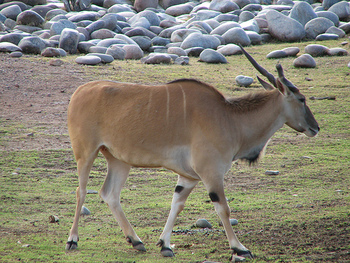 Eland antelope
Eland antelope
The San have an interesting belief concerning the death. If someone in group dies the group will leave and never make a camp on this place again.
They try to avoid places where someone is buried. But if they arrive on such a place they will throw some pebbles on the grave and quietly say few words to the spirits to ensure good luck. They never step on the grave as they believe that spirits are still active in the area above the grave.
The San people believe that there are the supreme gods associated with life and the rising sun and those let's say lesser ones which they associate with illness and death.
The Shamans have contact with lesser gods when they are performing trance dance. The San also believe in some other supernatural beings and spirits of the dead.
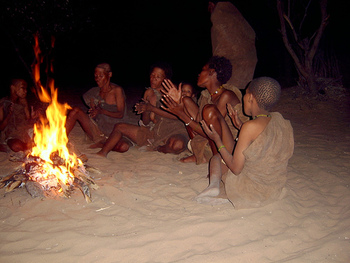 San people singing
San people singing
The San people believe that after death the soul goes to the great god’s house in the sky. Dead persons continue to influence the life of those alive.
Very important event in the life of boys is the day when they manage to kill their first antelope. Then they become adults.
When a girl is having her first menstruation she is isolated in her hut. On this day other members of the group perform the Eland Bull Dance.
The dance imitates the mating ritual of the Eland antelopes. One man imitates the Eland bull with horns on his head. The San people believe that this dance brings peace and beauty to the girl and make her safe from hunger and thirst.
Marriages are very simple. The groom gives the fat from the Elands' heart to bride's parents. She is later anointed with this fat.
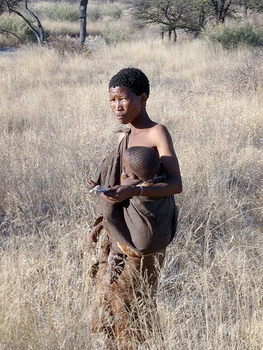 San woman and her baby
San woman and her baby
Nowadays the San people are having more and more problems to keep their traditional lifestyle as farmers use their land for feeding the cattle. Among other things this forces wild animals to change their usual migration routes which have been followed by the San people for thousand of years.
Despite bad treatment by the farmers some San individuals continue to work for them as helpers in finding of poachers. The San are famous for their tracking skills.
The Government also endangers the traditional lifestyle of the San. It is true that it tries to provide them with schools, water facilities etc. But on the other side it also forces the San people to live in permanent settlement which is the opposite to their traditional migrating lifestyle they are used to.
Their problem is also the fact that traditionally they do not have the term private ownership. That is why they face serious troubles in proving what land exactly belongs to them.
Let's finish this story about the San people by mentioning their brief role in the world of film. In 1980 Jamie Uys directed a film "The Gods must be Crazy". The story is about the San man Xi whose live has been disturbed by a bottle of Coke dropped from a plane. In 1989 the sequel of this film was made.